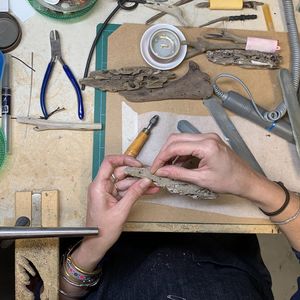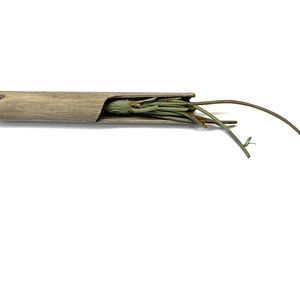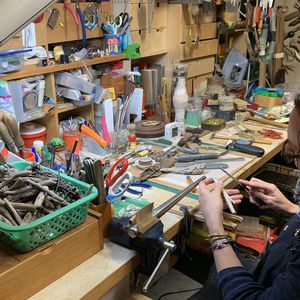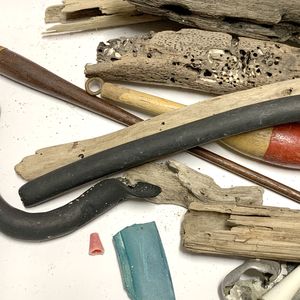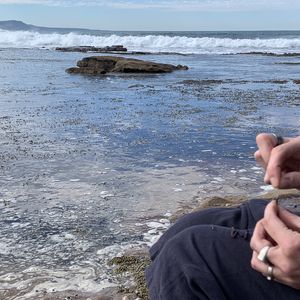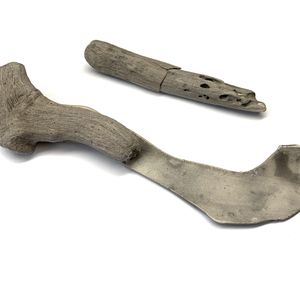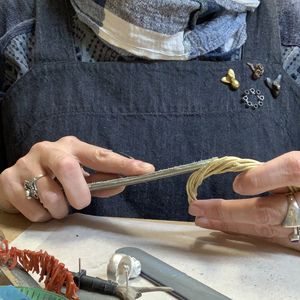Melinda Young
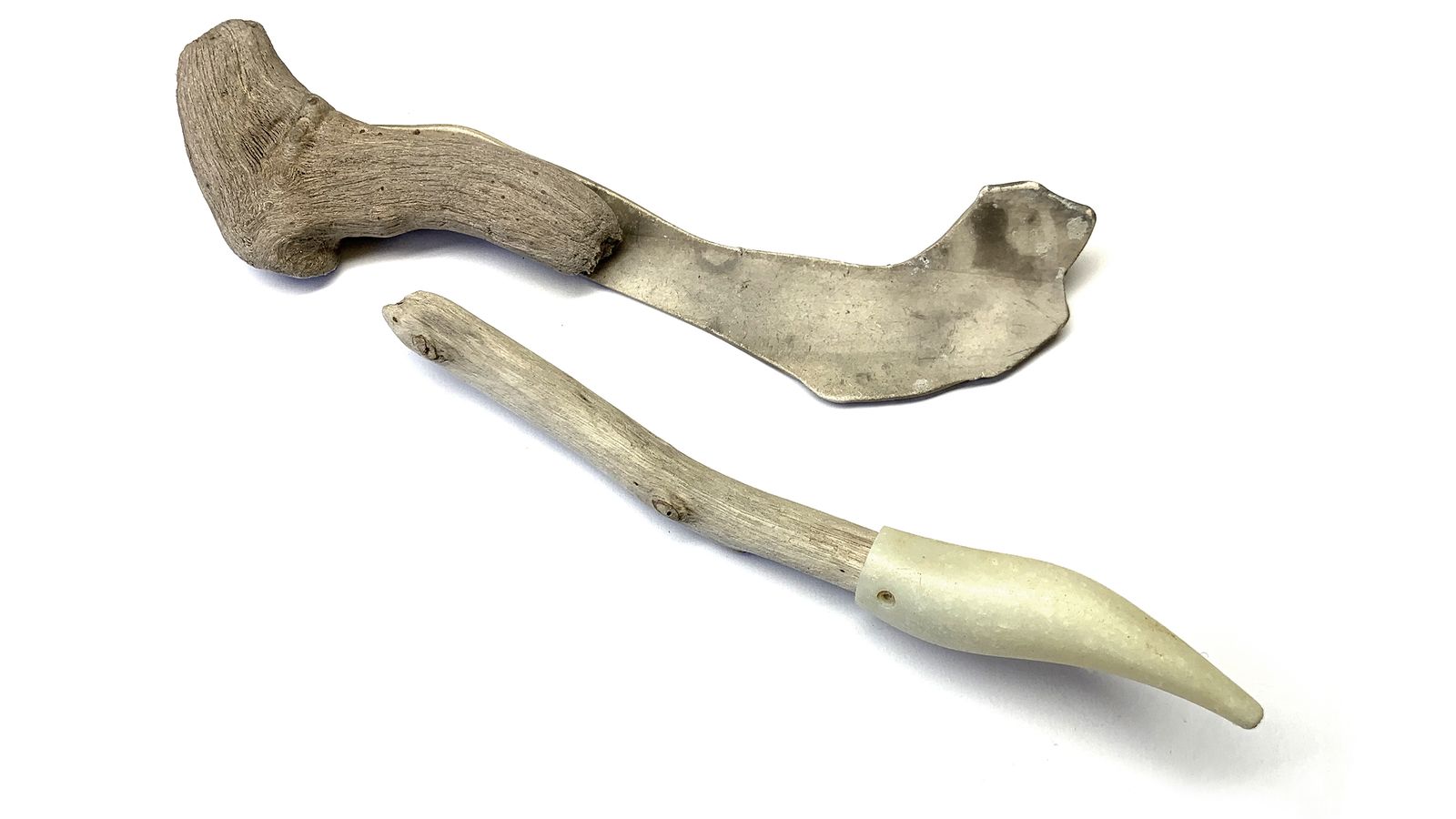
Isolate Make: Creative Resilience in a Pandemic explores how creative practice has adapted to isolation, associated restrictions and production challenges, or in response to the year’s tragic global events. Through images, text, video and final work on exhibition Isolate Make gives a unique insight into a wide range of contemporary art, craft and design practice.
The work reflects on being adrift and coming together. The idea that we are ‘together alone’ that has been so often used this year. The brooches have been arranged in a shape that reflects a large Arcus cloud that stretched from the south of Wollongong to Sydney on the afternoon of 20 April 2020. The cloud brought people together; my Instagram feed was filled with it - a tangible reminder that my friends and family were grounded together (apart) under the same sky, in extraordinary times. Melinda Young
IN CONVERSATION:
Who are you?
I’m a craftsperson, thinker/maker, educator and beachcomber who loves to travel and is deeply curious about the world. I am happiest when making, floating in the ocean or having adventures with my partner and our son.
Where do you work?
I work from my home-studio in Thirroul, which is a small coastal town on Dharawal country, 80 kilometres south of Sydney.
Describe your practice?
My practice is multidisciplinary – I work across a range of craft practices and with a wide variety of materials and techniques. Primarily the work I make is wearable; or made in relation to the human body.
How has the coronavirus pandemic affected your practice and your ability to make a living?
CV19 has had a huge impact on my practice, initially this saw numerous exhibitions, workshops and travel opportunities cancelled or postponed. Like most artists and craftspeople, my income took a hit with the cancellation of these events as well as the temporary closure of galleries that represent my work here and in New Zealand. However, these spaces have been doing amazing things to bring work online, and sales are slowly increasing. One of the most tangible positives to emerge from the switch to the online space is the opportunity to engage more broadly nationally and internationally through attending workshops and conferences online, this has been stimulating and exciting.
The lockdown earlier in the year, although scrambled and intense, ironically provided time and space to reconnect with the core themes of my practice and engage with new ideas, some would say a good time to start a PhD!
I am also extremely grateful to Lisa Cahill and the team at ADC for the incredible support and opportunities that have been offered to myself and the community this year – these have been such a beacon, providing the opportunity to reflect and create via the design/isolate journal project as well as make with purpose throughout the year towards isolate/make.
What are you making?
I am making a group of brooches using marine debris: driftwood, plastics and other ephemera collected during the CV19 Lockdown period from March – May 2020.
What is the concept behind this work?
The work reflects on being adrift and coming together. The idea that we are ‘together alone’ that has been so often used this year. The brooches have been arranged together in a shape that reflects the shape of a large Arbus cloud that stretched from south of Wollongong up to Sydney on the afternoon of 20 April 2020. A time when we were all still in lockdown here. The extraordinary cloud brought people together; my Instagram feed was filled with it - a tangible reminder that my friends and family were grounded together (apart) under the same sky, in extraordinary times.
What is the process of making this work?
The process of making this work has been deliberately slow and mindful. The driftwood and marine plastics were collected whilst walking along the beach during the lockdown. Each piece has now been converted into a wearable via the insertion of small handmade silver pins. Most pieces have been left as they were found, but others are material hybrids – the intervention (or imposition) of another material is deliberately disruptive, uncomfortable, strange.
Is this process the same or different to your usual process? If different, how has it changed?
I approach each new body of work with openness and try to work intuitively. So in that sense, the process is the same. I tend to sit with materials and wait for them to speak to me in some way. The technical process of adding the pin to the work in these pieces is different to my previous work, testing various approaches led to a pared back and simpler technical solution that allows for many different ways of positioning the brooches on a garment.
Has your thought process changed? If so, how and has that affected your work?
My thought process seems slowed down this year, perhaps reflected in making the pins in this work, which is repetitious and laborious. Although repetitive making processes seem to be a constant in my practice – once a technical solution has been found it can be repeated hundreds of times over, creating time and space for allowing thoughts to wander, my mind to wonder.
What is the value of making art right now?
Art making is everything. Always. Right now making art is absolutely a prescription for mental health.
How do you think your practice will change when we emerge from isolation?
Because I started studying again this year, I have already invited it to change. As someone who has always worked very simply and with the materials around me, I feel that this has become intensified even more.
This research has been conducted with the support of the Australian Government Research Training Program Scholarship.
This work was made on Dharawal Country. Melinda respectfully acknowledges the custodians and traditional owners of this land and pays respects to Elders past, present and emerging.
ABOUT MELINDA YOUNG
Melinda Young is a contemporary craft artist whose work spans jewellery, textiles, installation and interactive public art projects. She has exhibited extensively in Australia and internationally since 1997 and her work is held in public collections and included in numerous publications.
Melinda’s practice primarily engages with the idea of ‘place’ and explorations of materiality, with an emphasis on found or re-purposed materials as vehicles for narrative explorations of the landscape and the people who inhabit it.
Alongside her making practice, Melinda has spent the past 20 years working within the contemporary craft and design field as an educator, curator and gallery manager. Melinda is currently an Associate Lecturer at UNSW Art & Design and undertaking a cross-disciplinary PhD at the Australian Centre for Culture Environment Society and Space, University of Wollongong.

